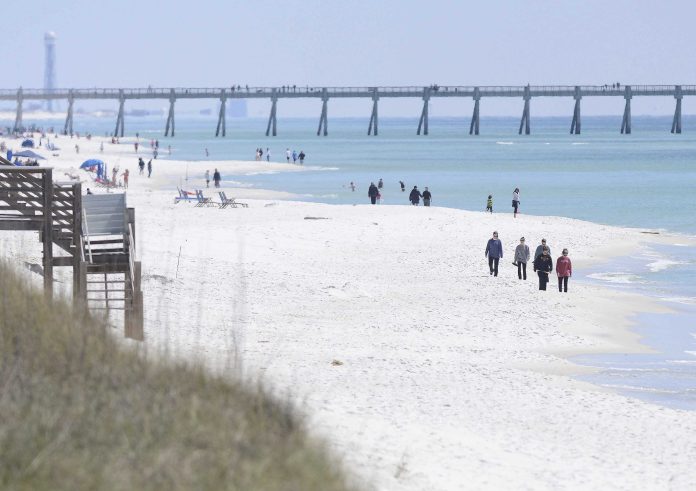
By JEFF MARTIN
Associated Press
Authorities are using boats to patrol the ocean and warning swimmers about sharks this weekend along Florida’s Gulf Coast, where a woman and two teenage girls were hurt in two separate shark attacks on Friday.
The attacks off beaches in the Florida Panhandle led authorities to temporarily close several beaches to swimmers on Friday. Beaches were reopened Saturday, with flags warning of high hazards.
“All I can say is that these incidents are very rare,” said Demian Chapman, a scientist and director of the Center for Shark Research at the Mote Marine Laboratory and Aquarium in Sarasota, Florida.
“It’s even more rare to have two events in one day involving three people,” he told The Associated Press on Saturday. “That’s astronomically low odds of that happening.”
In Walton County, the sheriff’s office, fire department and the state’s wildlife agency were working together to patrol the water with boats and the shore with vehicles, the South Walton Fire District said in an update Saturday. Both of Friday’s attacks happened in Walton County.
“Please swim carefully today, respect the Gulf, stay hydrated, and look out for your loved ones,” the fire department said on social media.
Red and purple flags were being used Saturday to warn swimmers of the dangers.
“Purple Flags indicate the presence of dangerous marine life and single red flags indicate high hazard conditions,” the Bay County Sheriff’s Office said in a social media post on Saturday.
Small fish are traveling in schools near the shore this time of year, which might have been a contributing factor in the attacks, the Bay County Sheriff’s Office said.
The first attack happened Friday afternoon when a woman was bitten by a shark near WaterSound Beach, the Walton County Sheriff’s Office said. She had critical injuries on her midsection and arm, and part of her arm had to be amputated, South Walton Fire Chief Ryan Crawford said at a news briefing. She was flown to a trauma center.
Less than two hours later, firefighters responded to another beach about 4 miles (6.4 kilometers) east of the first attack “following multiple reports of a teenager injured by a shark,” the sheriff’s office said.
Two teenage girls were in waist-deep water with a group of friends when they were attacked, the South Walton Fire District said.
“When lifeguards and deputies arrived on scene, they found one of the females had significant injuries to the upper leg and one hand,” fire officials said in an update. She was flown to a trauma center. The other teen had what officials described as minor injuries on one of her feet.
The two teenagers are from Mountain Brook, Alabama, a suburb of Birmingham, Mountain Brook City Manager Sam Gaston told the news site Al.com.
There’s no way of knowing whether it was one shark or two separate ones involved in Friday’s attacks, but there are more sharks in the Gulf of Mexico than in past years, Chapman said.
“There’s definitely been a recovery of sharks in the Gulf after many years of overfishing,” he said. “They’re sort of out there again after being depleted quite a bit.”
The time of the attacks — in the middle of the afternoon — was also an anomaly, Walton County Sheriff Michael Adkinson said. Sheriff’s officials often warn people to be aware of sharks early in the morning and at dusk, their typical feeding times, he noted.
On Saturday, Walton County sheriff’s deputies patrolling the waters in a boat spotted a 14-foot hammerhead shark near Santa Rosa Beach, which they said is not unusual. Sheriff’s officials say they don’t know what type of shark attacked the swimmers on Friday.
“We want to reiterate that sharks are always present in the Gulf,” the sheriff’s office said in a Saturday post on social media. “Swimmers and beachgoers should be cautious when swimming and stay aware of their surroundings.”
Also Friday, in Hawaii, a woman was seriously injured in an apparent shark attack in the waters off the island of Oahu, officials said.
Shark attacks are rare, according to experts. There were 69 unprovoked bites last year worldwide, and 10 of those were fatal, according to the University of Florida’s International Shark Attack File. That was higher than the recent average of six deaths per year.



















